|
 This is a diagram of what I thought was a great idea, when I was 11 years old in 1953, and flying
saucers were hot items in the news. Anyone with the slightest knowledge of aerodynamics and Newton's Third
Law of Motion should see the silliness of the thing. In fact, at the time, my science mentor, Mrs. Frietag, had
explained that the disk would block the downward flow of air from the prop, so that no net lift would be produced.
And, as I figured out later, the motor would not have had enough power to move much air anyway. The general rule is
that to get "lift," air has to be pushed downward. Not until I was in college did I really begin to understand what Mrs. Freitag
had been trying to tell me, but by then the idea of having a way to rise vertically in the air had become fixed in my technical
imagination. Even after I realized that this specific version of the idea was unworkable, I still wanted to make a vertical-lift
machine of some sort, especially one that didn't have a high-speed prop swinging through the air.
This is a diagram of what I thought was a great idea, when I was 11 years old in 1953, and flying
saucers were hot items in the news. Anyone with the slightest knowledge of aerodynamics and Newton's Third
Law of Motion should see the silliness of the thing. In fact, at the time, my science mentor, Mrs. Frietag, had
explained that the disk would block the downward flow of air from the prop, so that no net lift would be produced.
And, as I figured out later, the motor would not have had enough power to move much air anyway. The general rule is
that to get "lift," air has to be pushed downward. Not until I was in college did I really begin to understand what Mrs. Freitag
had been trying to tell me, but by then the idea of having a way to rise vertically in the air had become fixed in my technical
imagination. Even after I realized that this specific version of the idea was unworkable, I still wanted to make a vertical-lift
machine of some sort, especially one that didn't have a high-speed prop swinging through the air.
Over the years, I've taken the idea up, as happened a few weeks ago, when I decided to abandon vaporizers.
Then friends sent me links to two interesting videos: One shows an amazing mechanical hummingbird
with awesome maneuverability; the other shows a "HexaKopter" that has the
most stunning control features. 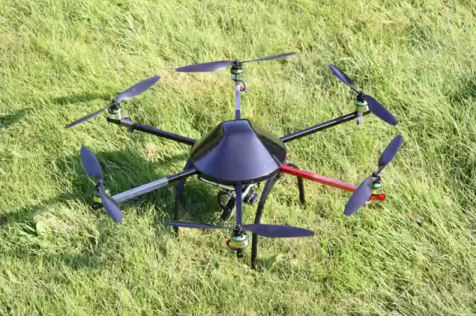 These two videos encouraged my
thinking about my own vertical-lift project. These two videos encouraged my
thinking about my own vertical-lift project.
In the mid 1980s, I was introduced to a guy named Steve Soter who worked at the Air & Space Museum. Steve
commented one day that that no one at the museum had a concept of aerodynamic lift on the molecular scale. He said to think about it,
that an exhibit might derive from any insights on the matter.
No insight was immediately forthcoming, but I kept thinking about how air molecules interact with
flow surfaces, and I finally figured out an explanation of the Coanda Effect
(pronounced KWAN-da), which is the tendency of a fluid flow (gas or liquid) to cling to and follow a curved surface. (The Effect,
which is to me more surprising in the case of compressible flows than incompressible flows [liquids] is related to the tendency of,
in least in incompressible flows, of stream of moving gas to entrain portions of the stationary adjacent air into itself; the
in-coming air carries momentum that, in effect, pushes the flow against the curved surface.)
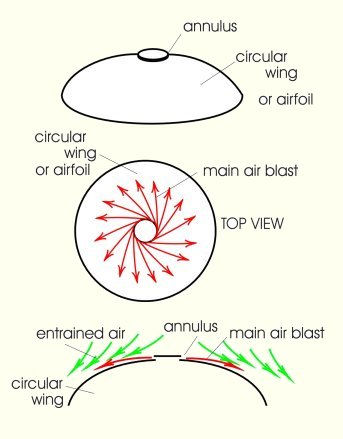 I figured that if you push air outward, radially, from the center
of a circular wing, lift should be produced. I needed to test that idea. I figured that if you push air outward, radially, from the center
of a circular wing, lift should be produced. I needed to test that idea.
I move slowly on ideas, so it wasn't until sometime in the 1990s that I rigged up a test.
 I machined an "airfoil" about six centimeters
in diameter (about 2.5 inches) out of acrylic, as shown, with allowance for water to be pumped up a central pipe to a small, central, flat
plate (not shown) that directed the flow radially outwards. I put the test setup in a fish tank filled with water. I could measure
the deflection of the spring (which is hard to see) as a function of the water flow rate and verify my idea. It worked; one could use
an arrangement like this in a swimming pool, with a garden hose supplying the water, for propulsion. A battery-powered water pump
could work in water nearly anywhere, and without the hazards associated with an exposed propeller. I machined an "airfoil" about six centimeters
in diameter (about 2.5 inches) out of acrylic, as shown, with allowance for water to be pumped up a central pipe to a small, central, flat
plate (not shown) that directed the flow radially outwards. I put the test setup in a fish tank filled with water. I could measure
the deflection of the spring (which is hard to see) as a function of the water flow rate and verify my idea. It worked; one could use
an arrangement like this in a swimming pool, with a garden hose supplying the water, for propulsion. A battery-powered water pump
could work in water nearly anywhere, and without the hazards associated with an exposed propeller.
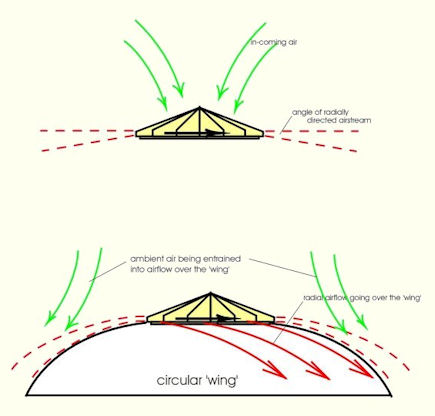 Next I began to think about radial air pumps to hurl air radially outward over a circular wing. The problem of how to make
a light-weight circular wing was difficult, and still is, so I focused on testing radial air pumps, some of which had diameters
of up to 30 inches; the large ones were made of sheets of eighth-inch and quarter-inch foam core, and the smaller ones
were made of brass.
Next I began to think about radial air pumps to hurl air radially outward over a circular wing. The problem of how to make
a light-weight circular wing was difficult, and still is, so I focused on testing radial air pumps, some of which had diameters
of up to 30 inches; the large ones were made of sheets of eighth-inch and quarter-inch foam core, and the smaller ones
were made of brass. 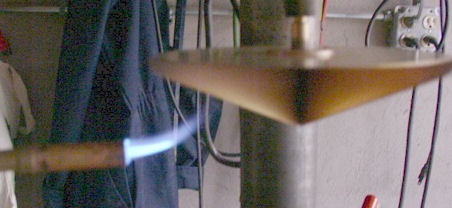 Here's a view of a brass impeller mounted upside down in my drill press, with a torch flame showing how
it pulled air into it. Here's a view of a brass impeller mounted upside down in my drill press, with a torch flame showing how
it pulled air into it.
Here's my latest sketch of the shapes of the impeller and circular wing that I hope to build.
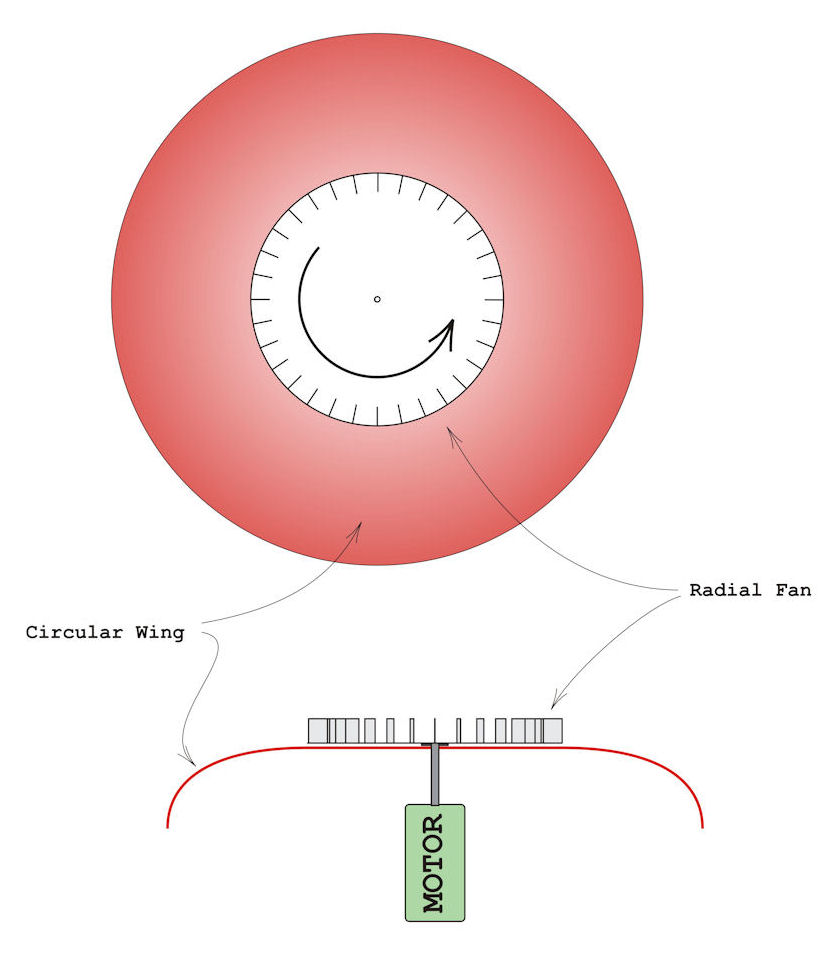 I don't have any insight yet into
how to build a light-weight circular wing, but I do have some options. As for the impeller, it does not have to be strong
because it is not a compressor, but rather only a fan. The exact shape of the wing is also unresolved, but for the purposes
of making progress, nearly any smooth surface that curves to a straight downward direction should give some sort of useful result.
As for the motor, there are some amazing ones available at the local hobby store. The batteries will be the sort I use in
the Tobacco Master vaporizer. I don't have any insight yet into
how to build a light-weight circular wing, but I do have some options. As for the impeller, it does not have to be strong
because it is not a compressor, but rather only a fan. The exact shape of the wing is also unresolved, but for the purposes
of making progress, nearly any smooth surface that curves to a straight downward direction should give some sort of useful result.
As for the motor, there are some amazing ones available at the local hobby store. The batteries will be the sort I use in
the Tobacco Master vaporizer.
This vertical lift idea will not have the dramatic upward acceleration of the
HexaKopter, but it won't have problems with trees and walls,
and if the power fails at altitude, its descent should be not so bad.
Bob
|
 This is a diagram of what I thought was a great idea, when I was 11 years old in 1953, and flying
saucers were hot items in the news. Anyone with the slightest knowledge of aerodynamics and Newton's Third
Law of Motion should see the silliness of the thing. In fact, at the time, my science mentor,
This is a diagram of what I thought was a great idea, when I was 11 years old in 1953, and flying
saucers were hot items in the news. Anyone with the slightest knowledge of aerodynamics and Newton's Third
Law of Motion should see the silliness of the thing. In fact, at the time, my science mentor,  These two videos encouraged my
thinking about my own vertical-lift project.
These two videos encouraged my
thinking about my own vertical-lift project. I figured that if you push air outward, radially, from the center
of a circular wing, lift should be produced. I needed to test that idea.
I figured that if you push air outward, radially, from the center
of a circular wing, lift should be produced. I needed to test that idea. I machined an "airfoil" about six centimeters
in diameter (about 2.5 inches) out of acrylic, as shown, with allowance for water to be pumped up a central pipe to a small, central, flat
plate (not shown) that directed the flow radially outwards. I put the test setup in a fish tank filled with water. I could measure
the deflection of the spring (which is hard to see) as a function of the water flow rate and verify my idea. It worked; one could use
an arrangement like this in a swimming pool, with a garden hose supplying the water, for propulsion. A battery-powered water pump
could work in water nearly anywhere, and without the hazards associated with an exposed propeller.
I machined an "airfoil" about six centimeters
in diameter (about 2.5 inches) out of acrylic, as shown, with allowance for water to be pumped up a central pipe to a small, central, flat
plate (not shown) that directed the flow radially outwards. I put the test setup in a fish tank filled with water. I could measure
the deflection of the spring (which is hard to see) as a function of the water flow rate and verify my idea. It worked; one could use
an arrangement like this in a swimming pool, with a garden hose supplying the water, for propulsion. A battery-powered water pump
could work in water nearly anywhere, and without the hazards associated with an exposed propeller. Next I began to think about radial air pumps to hurl air radially outward over a circular wing. The problem of how to make
a light-weight circular wing was difficult, and still is, so I focused on testing radial air pumps, some of which had diameters
of up to 30 inches; the large ones were made of sheets of eighth-inch and quarter-inch foam core, and the smaller ones
were made of brass.
Next I began to think about radial air pumps to hurl air radially outward over a circular wing. The problem of how to make
a light-weight circular wing was difficult, and still is, so I focused on testing radial air pumps, some of which had diameters
of up to 30 inches; the large ones were made of sheets of eighth-inch and quarter-inch foam core, and the smaller ones
were made of brass.  Here's a view of a brass impeller mounted upside down in my drill press, with a torch flame showing how
it pulled air into it.
Here's a view of a brass impeller mounted upside down in my drill press, with a torch flame showing how
it pulled air into it. I don't have any insight yet into
how to build a light-weight circular wing, but I do have some options. As for the impeller, it does not have to be strong
because it is not a compressor, but rather only a fan. The exact shape of the wing is also unresolved, but for the purposes
of making progress, nearly any smooth surface that curves to a straight downward direction should give some sort of useful result.
As for the motor, there are some amazing ones available at the local hobby store. The batteries will be the sort I use in
the
I don't have any insight yet into
how to build a light-weight circular wing, but I do have some options. As for the impeller, it does not have to be strong
because it is not a compressor, but rather only a fan. The exact shape of the wing is also unresolved, but for the purposes
of making progress, nearly any smooth surface that curves to a straight downward direction should give some sort of useful result.
As for the motor, there are some amazing ones available at the local hobby store. The batteries will be the sort I use in
the